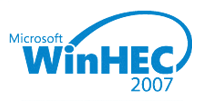Solid-State Drive Industry Leaders Seem to Be Hedging Bets
 LOS ANGELES - A panel of four leading figures in the marketing and engineering of solid-state drives, convening toward the end of WinHEC 2007, appeared to agree that the development of solid-state disk drives and hard drives that use flash memory as intermediate caches, even as flash technologies evolve and NAND prices continue to avoid bottoming out, will never result in the replacement of traditional HDDs for any market category.
LOS ANGELES - A panel of four leading figures in the marketing and engineering of solid-state drives, convening toward the end of WinHEC 2007, appeared to agree that the development of solid-state disk drives and hard drives that use flash memory as intermediate caches, even as flash technologies evolve and NAND prices continue to avoid bottoming out, will never result in the replacement of traditional HDDs for any market category.
A representative of Texas Memory Systems, which produces flash-equipped components for storage, admitted that customers approach his company when they are looking to improve their systems' performance, not storage. That sentiment was validated by three other members of the panel and a moderator representing Microsoft.
At one point, Seagate's market development manager Josh Tinker invoked an analogy dealing with the evolution of the personal transportation industry, where the mode of transport migrated over the past few hundred years from the backs of animals to the internal combustion engine. The migration ahead of us there, he said, was to the electric engine. How does that come about? "The first step," Tinker said, "is hybrid."
Which would seem to say the whole industry needs to move to flash/HDD hybridization first, before moving to totally solid-state memory solutions. But none of the panelists would commit to the idea implied by the analogy.
Tinker challenged panelists and attendees alike to inject some reality into the discussion, pointing out that while the new entry point price for HDDs is about $40 for a 60 GB 2.5" notebook drive, the entry point for SSDs is about $500 for 32 GB capacity. As capacities increase, the price scales increase at different rates, with flash-supplemented device prices increasing more rapidly.
As time goes on and prices continue to fall, Tinker and the other panelists seemed to agree with BetaNews' suggestion that while both price scales decline, a formidable gap may continue to exist between SSDs/hybrid drives and conventional HDDs. But as SanDisk's representative believes, the size of the gap itself will diminish over time. Then, he believes, total cost of ownership will be evaluated, after which time, the benefits of SSD over longer periods may become self-evident.
Which brought up a question from the audience: When will there be a flip-flop, where hybrids take over as standard PC components, and the price scales swap places? Five years? Ten years? Never? Even Texas Memory Systems agrees...that's a Very Good Question. "There's this time it takes for adoption in the enterprise," he said, "and that's really held it back. But I do see this opportunity for the future as things become more developed. It just takes more time."
As the panel was convening, Microsoft confirmed a development here at WinHEC that the company is committing to producing a new bus controller interface for non-volatile memory (NVM) by the end of this year.